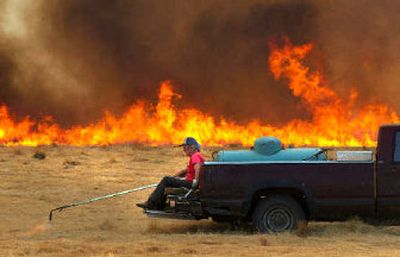Planned burn jumps field

Unexpected wind shifts Tuesday afternoon caused a bluegrass fire to jump into a neighboring field off Meyer Road and burn about 40 acres.
Farmers quickly controlled the rogue fire, but it made for an exciting start to the opening day of field burning on the Rathdrum Prairie, where about 800 acres of stubble burned. Growers had planned to burn the field anyway, just not Tuesday.
“We were glad they were able to respond as quickly as they did,” said Wayne Hoffman, Idaho State Agriculture Department spokesman. “They put it out as practiced and planned.”
Yet the wind change caused thick, black smoke to hit Rathdrum, said Mark Boyle, an air quality analyst for the Idaho Department of Environmental Quality. Luckily the winds cleared out the plume within a half-hour, he said.
Smoke levels also were elevated in Athol and Hope, but overall Boyle defined air quality as moderate, just as it was in the morning before the burns started.
Growers on the populated prairie are slated to light another 800 acres today, but the state won’t make the final call until consulting with meteorologists early this morning.
Residents who want to track field burning activity can find regularly updated information, including the size of permitted burns, on the department’s Web site, www.idahoag.us.
Patti Gora and other volunteers with the Sandpoint-based Safe Air For Everyone monitored the blazes and ranked the day’s burns as poor.
“The community of Bayview was completely socked in with smoke,” said Gora, who added that her own throat was sore and her car reeked of grass smoke. “People were driving with their lights on in the middle of the afternoon.”
Field burning also was approved Tuesday for 200 acres in Boundary County and 500 acres on the Coeur d’Alene Tribe reservation.
Bluegrass farmers say burning is the fastest, cheapest method of removing crop stubble.
Burning also reduces the need for the use of chemical weed killers on the Rathdrum Prairie, which sits atop the region’s drinking water aquifer. Farmers grow grass seed for use in lawns and golf courses.